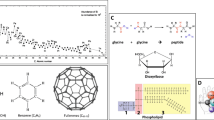Abstract
Depleted uranium used as ammunition corrodes in the environment forming mineral phases and then dissolved uranium species like uranium carbonates (Schimmack et al., in Radiat Environ Biophys 46:221–227, 2007) and hydroxides. These hydroxide species were contacted with plant cells (canola). After 24 h contact time the cells were fractionated and the uranium speciation in the fraction was determined by time resolved laser-induced fluorescence spectroscopy at room temperature as well at 150 K. It could be shown that the uranium speciation in the fractions is different to that in the nutrient solution. Comparison of the emission bands with literature data allows assignment of the uranium binding forms.







Similar content being viewed by others
References
Barkleit A et al (2008) Interaction of uranium(VI) with lipopolysaccharide. Dalton Trans 21:2879–2886
Bell JT, Biggers RE (1965) Absorption spectrum of uranyl ion in Perchlorate media. I. Mathematical resolution of overlapping band structure and studies of environmental effects. J Mol Spectrosc 18:247–275
Bernhard G, Geipel G (2007) Bestimmung der Bindungsformen des Urans in Mineralwässern. Vom Wasser 105(3):7–10
Brachmann A et al (2002) Study of uranyl(VI) malonate complexation by time resolved laser-induced fluorescence spectroscopy (TRLFS). Radiochim Acta 90:147–149
Bradford MM (1976) Rapid and sensitive method for quantitation of microgram quantities of protein utilizing principle of protein-dye binding. Anal Biochem 72:248–254
Brendler V et al (1996) Complexation in the system UO2 2+/PO4 3−/OH− (aq) : potentiometric and spectroscopic investigations at very low ionic strengths. Radiochim Acta 74:75–80
Decambox P et al (1991) Direct and fast determination of uranium in human urine samples by laser-induced time-resolved spectrofluorometry. Appl Spectrosc 45:116–118
Frost L et al (2011) Interaction of uranium(VI) towards glutathione—an example to study different functional groups in one molecule. Proc Radiochem A Suppl Radiochim Acta 1:357–362
Gabriel U et al (2001) Uranyl surface speciation on silica particles studied by time-resolved laser-induced fluorescence spectroscopy. J Colloid Interface Sci 239:358–368
Geipel G (2006) Laser-induced fluorescence spectroscopy. In: Vij DR (ed) Handbook of applied solid state spectroscopy. Springer, New York, pp 577–593
Geipel G et al (1998) Complex formation between UO2 2+and CO3 2−: studied by laser-induced photoacoustic spectroscopy (LIPAS). Radiochim Acta 82:59–62
Glorius M (2009) Zur Komplexbildung ausgewählter Actiniden (U, Np, Cm) mit mikrobiellen Bioliganden. Ph.D. thesis, TU Dresden
Guillaumont R et al (2003) Chemical thermodynamics, vol 5. Elsevier, Amsterdam 246
Günther A et al (2003) Uranium speciation in plants. Radiochim Acta 91:319–328
Günther A et al (2006) Complex formation of U(VI) with the amino acid l-threonine and the corresponding phosphate ester O-phospho-L-threonine. Radiochim Acta 94:845–851
Günther A et al (2011) Luminescence properties of uranium(VI) citrate and uranium(VI) oxalate species and their application in the determination of complex formation constants. Radiochim Acta 99:534–541
Koban A et al (2007) Uranium(VI) complexes with phospholipid model compounds—a laser spectroscopic study. J Inorg Biochem 101:750–757
Larsson C et al (1994) Isolation of highly purified plant plasma-membranes and separation of inside-out and right-side-out vesicles. Methods Enzymol 228:451–469
Lehmann S et al (2008) A novel time-resolved laser fluorescence spectroscopy system for research on complexation of uranium(IV). Spectrochim Acta A 73:902–908
Lütke L et al (2012) A new uranyl benzoate species characterized by different spectroscopic techniques. Radiochim Acta 100:297–303
Mihalik J et al (2012) Citrate assisted phytoextraction of uranium by sunflowers: study of fluxes in soils and plants and resulting intra-planta distribution of Fe and U. Environ Exp Bot 77:249–258
Palmgren MG et al (1990) Effect of detergents on the H+-ATPase activity of inside-out and right-side-out plant plasma-membrane vesicles. Biochim Biophys Acta 1021:133–140
Rauser WE (1999) Structure and function of metal chelators produced by plants—the case for organic acids, amino acids, phytin, and metallothioneins. Cell Biochem Biophys 31(1):19–48
Scapolan S et al (1998) Investigations by time-resolved laser-induced fluorescence and capillary electrophoresis of the uranyl-phosphate species: application to blood serum. J Alloys Compd 271–273:106–111
Schimmack W et al (2007) Long-term corrosion and leaching of depleted uranium (DU) in soil. Radiat Environ Biophys 46:221–227
Sachs S et al (2007) Uranium(VI) complexation by humic acid under neutral pH conditions studied by laser-induced fluorescence spectroscopy. Radiochim Acta 95(2):103–110
Viehweger K (2014) How plants cope with heavy metals. Bot Stud 55(1):35
Viehweger K, Geipel G (2010) Uranium accumulation and tolerance in Arabidopsis halleri under native versus hydroponic conditions. Environ Exp Botany 69:39–46
Wang et al (2004) Cryogenic laser induced fluorescence characterization of U(VI) in hanford vadose zone pore waters. Environ Sci Technol 38:5591–5597
Acknowledgments
For providing the spectra of uranium citrate and uranium benzoate A. Günther and H. Moll are gratefully acknowledged.
Author information
Authors and Affiliations
Corresponding author
Rights and permissions
About this article
Cite this article
Geipel, G., Viehweger, K. Speciation of uranium in compartments of living cells. Biometals 28, 529–539 (2015). https://doi.org/10.1007/s10534-015-9836-x
Received:
Accepted:
Published:
Issue Date:
DOI: https://doi.org/10.1007/s10534-015-9836-x




